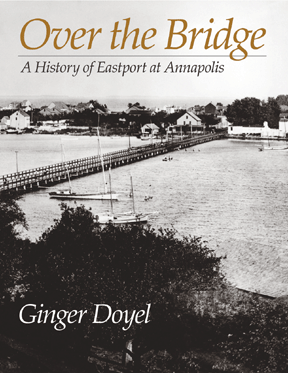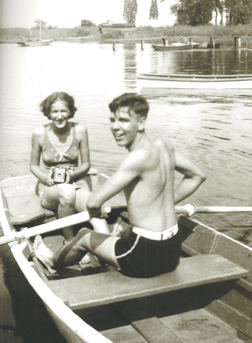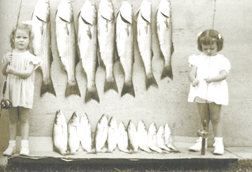
|
Volume 16, Issue 42 - October 16 - October 22, 2008
|
|
Columns |
A Scrapbook of Community
Over the Bridge, A History of Eastport, offers a you-can-do-it approach to history
by Ben Miller
Remember a time when you used to know everyone and the waterfront was open?
It was like that in days gone by — for many of us, in communities up and down the Bay.
People interviewed by historian and writer Ginger Doyel remember how it was in one community in a new book, Over the Bridge, A History of Eastport at Annapolis, published by the Annapolis Maritime Museum.
Over the Bridge is filled with engaging photographs and has the energy and appeal of a good scrapbook, plus the depth of scholarship that Doyel brought to the research.
Like a good scrapbook, the book is fun to read or to leaf through. Pictures of people catch your eye. You’ll see, as Doyel said, “the evolution of the peninsula from working boats to pleasure boats” and learn “the stories of people, the lesser known stories.”
The clean, uncluttered design enhances the photographs. The printing quality is high. Type is crisp and readable.
The photographs of Eastport, from the 1900s to the recent past, are beautifully reproduced in duotone. They’re local history for the people of Eastport, but for the rest of us, it’s like looking at the people of our own past in their prime. These photographs are the core of the book.
Candid cameras captured the people of Eastport as they fished, boated, swam, farmed, rode and drove horses, worked, played and posed for pictures.
The photographs show a community where people as diverse as Russian immigrant shopkeepers and African American oystermen found a place to live and work.
 |
Betty Neely, Sidney Ellen Simpson Zorn and Helen Bailey Simpson on Back Creek in the early 1940s, top.Mildred and Buddy Damn, shown rowing in the late ’30s, were frequent visitors from Baltimore. |
 |
“The story was driven by photographs,” said Doyel.
The stories — recollections, enhanced by Doyel’s descriptions — bring the images to life.
Doyel conducted several hundred interviews in compiling this book, and she shares the credit with her more than 600 contributing storytellers.
“The historic fabric of the book came from the community elders. I had many co-authors. The people of Eastport wrote this book,” Doyel said.
Filling a Void
Before Doyel began her work, there was “a huge void in the history of Eastport,” she said. Reference books and histories of Annapolis had little information about Eastport. Now the history of the people of Eastport is well documented.
This is “an incredibly important project,” said Heather Ersts, curator of the Annapolis Maritime Museum in Eastport.
Doyel’s research was especially timely, said Ersts, because a number of people have passed away since Doyel interviewed them for her book — among them Norwood Wetherhold, Peg Wallace and Elizabeth Lynhardt.
The Annapolis Maritime Museum will be the permanent home for the photographs and raw material of the book.
High resolution digital scans of nearly 2,000 photographs will become part of the museum’s collection.
The “photographs are a fantastic addition to the museum’s collection database and will some day be accessible online,” Ersts said.
Ersts is securing permission from the owners of the photographs to have copies of the images in the museum’s collection.
 |
James Johnson outside McNasby’s Oyster Company in the mid-50s. |
The museum will also receive Doyel’s research notes and the transcripts of her oral histories with Eastporters. The photographs and documentation will have lasting value for researchers into the history of Annapolis and Eastport.
The museum will develop a special exhibit on Eastport from the material. Many of the Eastport photographs will be incorporated into the new exhibit in McNasby’s Oyster Company building.
How to Turn a Scrapbook into History
Want to turn your own collection of images and memories into history? Ginger Doyel has advice for people in creating a book of their own.
1. Allow yourself time to tell the story with heart. Doyel worked from January 2007 through March 2008. Even though the book is finished, she is still receiving material.
2. Be ready to be flexible. She worked 24/7 to accommodate people’s schedules. Some people could only talk before 7am; others only after 9pm.
3. Understand that photographs are priceless and irreplaceable. Keep track of who owns the photographs, handle them with care and return them to their owners as soon as possible.
4. Collect everything to produce the fullest portrait of a community. Every fact or object — no matter how odd or insignificant — can help to tell the complete story.
 |
Over the Bridge, A History of Eastport is author Ginger Doyel’s fourth book. She has also written Annapolis Vignettes; Gone to Market: The Annapolois Market House, 1698-2005; The Annapolitan Club: A Tradition of Hospitality since 1897. |
Getting the Facts Straight
Our memories are fallible. We know this in our own lives. We forget when events happen. We forget some events; we remember others. We forget some people or their names; we remember others. We’ve all looked at family photographs and wondered, Who was that person? I wish Mother (or Father or Brother or Sister) had written something down. Scrapbookers creating a family album are aware of all this.
Those considering presenting local history can follow Doyel’s meticulous example in the accuracy of the facts she presents in Over the Bridge.
She was careful to properly identify people and places and to verify the dates in the book.
I asked her if she double-checked people’s recollections. “I double-checked them and triple-checked them,” she said.
Doyel corroborated facts with other people she interviewed. She talked with historians. She combed through archives. She looked at microfilm of copies of The Capital and the Washington Post. She confirmed addresses in old city directories. She sent captions for photographs back to the people who contributed them so they could check her accuracy.
Managing Plenty
 |
Harriet Williams and Janice Wood with the day’s catch in the late ’30s.Harry E. Lewis Sr. on the water with four of his daughters around 1924. |
 |
Over the Bridge contains 700 photographs, many loaned by the book’s contributors. Doyel selected that number from the nearly 2,000 she collected for the project. Choosing from good material is sometimes the hardest job.
What were Doyel’s criteria for selecting photographs?
She sought “a balance among people and places, landscapes and families.”
Doyel wanted to “show the diversity that has characterized Eastport throughout its history.” Immigrants from Europe, African Americans, tradesmen and merchants, watermen and yachtsmen, retired people and people starting families have all made Eastport their home over the years.
She chose photographs “never seen or published before” and “those that are most powerful and engaging.”
Doyel also “tied the photographs with the oral histories” she recorded. Often, Doyel said, the photographs opened up people and triggered their memories during her interviews. The book will trigger memories for the reader as well.
A Place Apart
So close to Annapolis, but always separate, Eastport felt different and was different. This comes across clearly in Doyel’s interviews conducted with present and past Eastport residents.
The bridge spanning Spa Creek never created a complete cultural connection between Eastport and Annapolis.
The title for Over the Bridge was suggested by sailor and sailboat racing commentator Gary Jobson. An apt phrase, for to this day Eastport holds itself separate.
Doyel organized her book around the three bridges that joined the two communities. First a wooden bridge, then an iron bridge and now the steel bridge we cross today.
Independent town, the Maritime Republic of Eastport or a neighborhood within the changing city of Annapolis, Eastport maintains its identity in reality and in the memories of those who once called and who still call Eastport home.
Team Effort for a Quality BookThe production of Over the Bridge was a “team effort,” said George Schenk, of the Whitmore Group of Annapolis, which printed the book. Schenk calls the “incredible images” collected by Ginger Doyel the heart of the book.
Book designer Gerard Valerio concurs. “There would have been no book without what she found,” Valerio said, referring to not only the images but also the identifying information Doyel unearthed. “This is one of the best books on the area that I’ve been involved in.” One challenge for Valerio was to make a virtue of the ordinary snapshot-quality photographs, with people staring straight at the camera. He varied the sizes, sometimes enlarging the photographs to catch the reader’s attention. For the same reason, Valerio mixed in a variety of land and water photos with those of people. The overall “challenge was to get people to stop [leafing through] and to encourage them to read the captions,” Valerio said. Text and captions in Palatino type are well designed and easy to read. Sherri Ferritto, of Typeline, Annapolis, did the typesetting. Schenk credits Annapolis PrePress and Peter Tasi, of Peter Tasi Design, for “enhancing the project by bringing out the details” of the original photographs in the high-resolution digital scans. Tasi scanned the photographs in color (not black and white) on a high-quality scanner at 300 DPI (dots per inch), storing the images as TIFF files. Tasi used Adobe Photoshop to “improve the value of the image.” He spent 14 hours to “historically reconstruct the photograph” of an aerial view of boats at the Eastport docks in order, as Tasi said, “to bring it back to life.” The photographs were printed in duotone by the Whitmore Group. This two-color process gave the images a “warm sepia feel that reflects the time,” Schenk said. The Whitmore Group regularly wins national awards for quality. The printer’s craftsmanship and high standards are reflected in Over the Bridge. Other team members were donors who advanced money for the book’s publication by the Annapolis Maritime Museum. Order Over the Bridge from the Annapolis Maritime Museum for $58.25: 410-295-0104. –Ben Miller |
